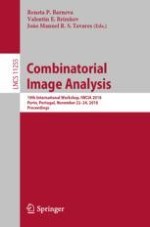This book constitutes the refereed proceedings of the 19th International Workshop on Combinatorial Image Analysis, IWCIA 2018, held in Porto, Portugal, in November 2018.
The 18 revised full papers presented were carefully reviewed and selected from 32 submissions. The papers are grouped into two sections. The first one includes nine papers devoted to theoretical foundations of combinatorial image analysis, including digital geometry and topology, array grammars, tilings and patterns, discrete geometry in non-rectangular grids, and other technical tools for image analysis. The second part includes nine papers presenting application-driven research on topics such as discrete tomography, image segmentation, texture analysis, and medical imaging.
